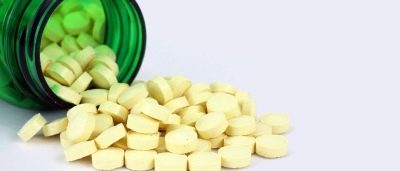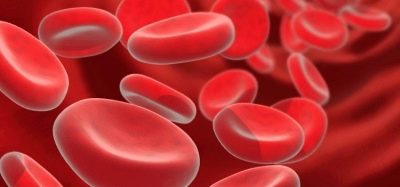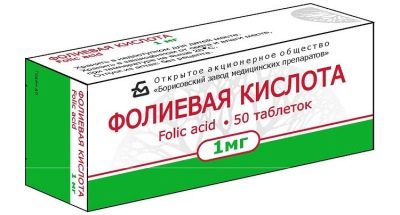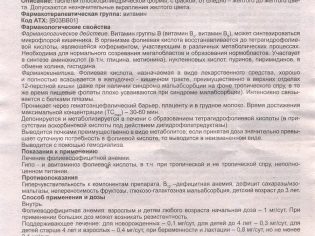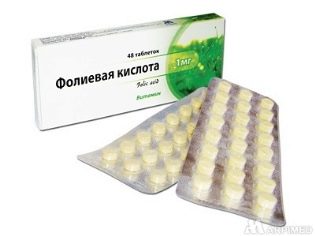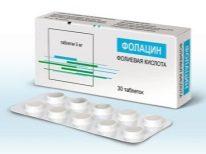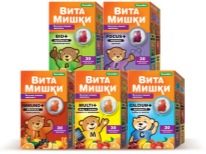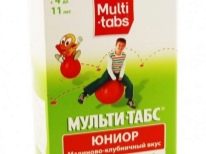Folic acid for children: instructions for use
Folic acid belongs to the group B vitamins (it is vitamin B9) and is very often given to expectant mothers: both for women who are just planning a pregnancy, and for those who are already carrying a baby. This is due to the ability of such a vitamin compound to protect the embryo from harmful effects, as well as positively affect the maturation and function of the placenta.
However, in some cases, folic acid is prescribed and children. It is part of many multivitamin supplements, but is also available separately - in the form of a drug, which is also called “folic acid”. Before you give this drug to a child, you need to find out how it affects the children's body and in what cases it is used in children.
Release form and composition
All drugs, the main ingredient of which is folic acid, are available only in solid form. Often these are round tablets of yellow color. For some manufacturers, they are film coated. Sometimes there is a risk on one of the tablet surfaces. “Folic acid” is sold both in blisters and in jars. The number of tablets in one package most often is 50 pieces, but it can also be smaller (10, 20, 25, 30 and 40 tablets), and large (75 or 100 tablets).
The dosage of folic acid in one tablet can be:
- 400 mcg;
- 1 mg;
- 5 mg.
The lowest dose of vitamin A is contained in the drug from "Valenta Pharmaceuticals", which is called "9 months of folic acid." Auxiliary ingredients from different manufacturers differ and may include lactose, copovidone, stearic acid, sucrose, potato starch, MCC and other substances.
Operating principle
The benefits of vitamin B9 is its participation in the metabolism and the formation of blood cells. Folic acid is very important for different processes in the human body and for the normal function of different organs. Once in the human body, this vitamin becomes tetrahydrofolic acid, which is involved in the exchange reactions in the form of coenzyme.
It is necessary for blood formation, since it ensures the normal maturation of red blood cells and activates erythropoiesis. Without a sufficient amount of folic acid, the formation of normoblasts is disrupted, causing larger cells to appear in the blood, called macrocytes.
In addition, this coenzyme is involved in the synthesis of nucleic acids (which is important for the formation of RNA and DNA) and some amino acids. No less important is folic acid for choline metabolism and iron absorption.
The active substance of the tablets is absorbed in the intestine almost at full dose and after 30–60 minutes is found in the bloodstream at maximum concentration. Metabolic changes of folic acid occur in the intestine and liver, and excretion occurs with urine.
Indications
“Folic acid” is prescribed when a deficiency of vitamin B9 is detected in the body or to prevent its shortage, the cause of which may be:
- increased need for vitamins: when carrying a child, during active growth, with anemia, skin diseases, and so on;
- insufficient amount of folic acid in food, for example, with an unbalanced diet;
- impaired absorption of the vitamin in the intestines: in celiac disease, dysbiosis, enteritis, malabsorption syndrome, sprue and other diseases.
The symptoms that occur when folic acid deficiency include pale skin color, weakness, growth retardation, restless sleep, emotional instability, poor appetite, the appearance of stomatitis, fatigue and other ailments.
Vitamin deficiency increases gradually and, if not eliminated in time, can provoke serious violations.
The need for folic acid in a child depends on age:
- up to one year the baby should receive it daily in the amount of 25 mcg;
- a one-year-old toddler and a 2-year-old child need 50 µg of this vitamin per day;
- children 3–6 years of age need 75 μg of folic acid daily;
- a school-age child (7–10 years old) should receive this vitamin in a daily dosage of 100 mcg;
- in adolescence, needs grow to 200 mcg per day.
As you can see, these dosages are much lower than the vitamin content in tablets, therefore, for preventive purposes, this medicine is prescribed less frequently for children. Most often in childhood, the drug is used for folic deficiency anemia, as well as in the complex treatment of other types of anemia. But in adults (in particular, women who are carrying a child or breastfeeding him) "Folic acid" is in demand primarily for prevention.
Studies have confirmed that taking pills during pregnancy and during breastfeeding helps:
- avoid miscarriage;
- reduce the risk of pathologies of the nervous system in the baby;
- prevent exfoliation of the placenta;
- reduce the likelihood of preeclampsia;
- prevent anemia in a premature baby.
Newborns get enough folic acid from mother's milk. If the infant receives infant formula, is born prematurely, or has any bowel disease, then the doctor should suggest how to prevent the development of hypovitaminosis with the help of nutritional correction or vitamin supplements.
How old is allowed?
Since “Folic acid” is presented only as a tablet form, it is prescribed to children over 3 years old, because such patients usually swallow the tablet without difficulty.
Contraindications
In addition to age restrictions, the use of "folic acid" has a few more contraindications. First of all, it is hypersensitivity to vitamin B9 or any of the additional substances in the composition of the tablets. Since most drugs contain lactose or sucrose, the medication is not prescribed for hereditary diseases in which carbohydrate metabolism is disturbed.
Patients with malignant tumors should be given “folic acid” with caution. And also it is not recommended to take this vitamin without a doctor’s control if there is a shortage of cobalamin and the development of B12-deficiency anemia. In this situation, folic acid can improve blood counts, but it will hide neurological problems.
For this reason, when erythropenia is detected, neutropenia, low hemoglobin, or changes in other indicators of the general blood test, you must first undergo additional examinations and only then take Folic Acid if the tests confirm that it is really necessary.
Side effects
Some children react to the medication by itching, erythema, nausea, abdominal distention or skin rash. In such a situation, medication should be stopped. Taking the pills too long can lead to B12 hypovitaminosis.
How and when to give the drug?
According to the instructions for use tablets taken after meals and washed down with clean water. The dosage is prescribed individually, because it depends on the reason for using “Folic acid” and on the age of the child. Sometimes treatment begins with higher dosages, and then adjust them to the reaction of the child’s body. The duration of the reception should be determined by the doctor, taking into account the diagnosis and the positive dynamics, but the tablets usually do not take longer than 30 days in a row.
If the dose that was prescribed to a small patient is less than 500 mcg (half tablets), then it will be difficult to divide the drug into the desired pieces. In such a situation, a solution is prepared from the drug using uncoated tablets. For its preparation take boiling hot water in a volume of 25 ml and 1/4 tablet, which corresponds to 250 μg of folic acid.
In 1 ml of the resulting solution will be 10 μg of vitamin compounds, which allows you to give the child the required amount of medication. After giving the medicine to the child, the remaining solution must be poured out, and the next day you should prepare a new one from another pill.
Overdose
Vitamin B9, like other B vitamins, is considered water soluble. This means that it does not accumulate in the body, if it comes in a small excess, but is simply excreted in the urine. However, with a very significant dose excess, the appearance of negative symptoms on the part of the central nervous system and the digestive tract (nausea, flatulence, worsening of sleep, nervous excitement, etc.) is possible.
Interaction with other drugs
Absorption of "folic acid" is worsened when combined with some antibiotics: tetracycline, neomycin, chloramphenicol and others. Treatment with anticonvulsant drugs increases the need for vitamin B9, and antacids and colestyramine reduce the absorption of the drug in the intestine. The effect of taking folic acid will be lower if you simultaneously take Methotrexate, Trimethoprim and similar medicines.
Terms of sale
Tablets are sold without a prescription and are available in all pharmacies, and their price depends on the packaging and manufacturer. On average, 50 tablets of 1 mg can be purchased for 30 rubles.
Storage conditions
Keep the medication at home is advised at a temperature of up to +25 degrees. A dry place hidden from children is best for storage. Shelf life of "folic acid" is usually 3 years.
Reviews
Almost all reviews of "folic acid" are positive and confirm the beneficial effect of such a vitamin on the body. The advantages of the drug include its availability and low cost, as well as the small size of the tablets (they are easy to swallow). Adverse reactions, according to parents, are very rare, but they are indicated in a few negative reviews about the drug.
Analogs
In the pharmacy you can find tablets called "Folacin", the main ingredient of which is also folic acid in a dosage of 5 mg per tablet. The drug is produced in packs of 10-30 pieces and is prescribed for the same indications as "Folic acid".
For anemia, instead of “Folic acid” tablets, complex medicines may be prescribed, in which vitamin B9 is supplemented with various forms of iron. These include drugs "Biofer", "Actiferrin compositum "and"Maltofer Foul". It is possible to give such medicines to a child only as prescribed by a doctor.
In order to prevent the appearance of a folic acid deficiency, complex supplements can be used, including, in addition to this compound, other vitamins, as well as mineral substances. Among children's multivitamins, Multi-Tabs, Pikovit, Vitamishki, Alphabet, Kinder Biovital, Vitrum Junior and Jungle are in demand.
In addition, it is important to ensure that the child receives enough folic acid from food. This vitamin is rich in green vegetables, yolks, cheeses, nuts, cereals, offal, fish, avocados, tomatoes, beets and other products.
However, we must remember that culinary processing significantly reduces the amount of folic acid, as well as long-term storage of products.
In the next video, TV presenter Gabriela Masanga decided to find out from Dr. Komarovsky which vitamins are best given to a child.


